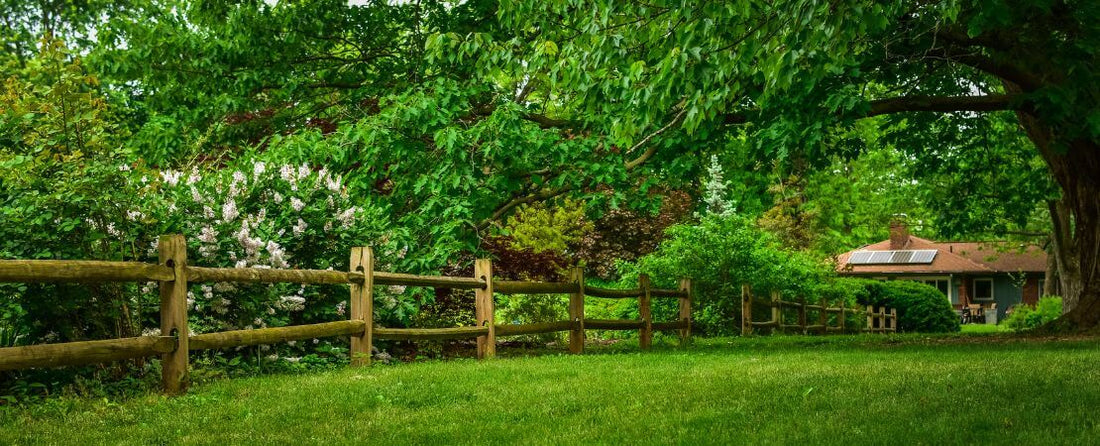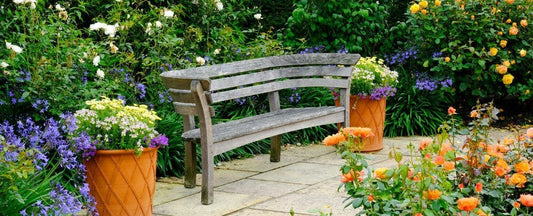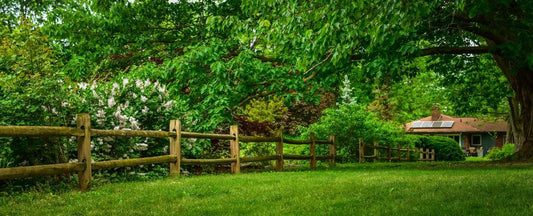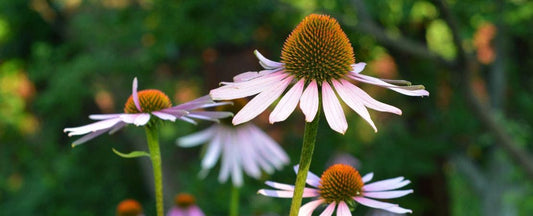Natural Garden Privacy: Three Beautiful Ways to Reduce, Reuse, and Retreat

On a quiet Saturday morning, a neighbor steps onto their patio with coffee and suddenly remembers the new second-story window across the fence. That’s the modern garden tension: we crave fresh air and birdsong, but our lots are closer and our lives more visible. The solution doesn’t have to be a tall, sterile wall. Today’s most inspiring privacy trend is natural screening, solutions that look like they’ve always belonged: living privacy fences, woven branch (wattle) fences, and dead hedges.
These aren’t just ways to hide a view. They cool the space, filter wind and street noise, and give birds and pollinators a reason to linger. And they’re deeply sustainable in fact, many rely on the pruned branches you already have.
3 Paths to Natural Privacy
When gardeners talk about natural privacy screens, they usually mean one of three approaches. Each has its own style, one you grow, one you weave, and one you build from prunings, but all three protect sightlines, soften noise, and welcome wildlife.
- The first path ends at a living fence. Evergreens stitched with flowering shrubs. It’s not instant, but it grows richer each season, like a good hedge should.
- The second turns toward a wattle fence, a graceful weave of flexible branches that looks like it leaps from a privacy screen instead of installing a hard panel. Kept clipped and architectural, it feels formal; left a little looser and woodland-inspired, it softens edges and invites birds and pollinators. The payoff is bigger than privacy, cooler patios, calmer wind, and four-season structure that matures with your landscape.
- For instant craft and character, there’s the woven branch fence, a traditional wattle fence made by threading flexible branches between upright stakes. It’s privacy you can build in a weekend, using pruned branches that curve gracefully around a seating area or along a path. Train clematis or honeysuckle over the weave and the panel becomes a living backdrop by summer.
And then there’s the ultimate sustainability move: the dead hedge (brushwood and yard scrap fence). Two rows of stakes with garden prunings layered between create a rustic, habitat-rich screen that looks at home along woodland edges and veggie plots. It’s quick, low-cost, and brilliant for wildlife, slowly composting in place as you top it up each season.
There’s an honest tradeoff across the trio: living hedges take two to five growing seasons to fully knit; wattle fences offer privacy now but weather gradually; dead hedges deliver instant cover and biodiversity with a wilder look. Many gardeners combine them by weaving or stacking for today and planting for tomorrow, so the garden feels private right away while the hedge grows into a lasting sanctuary.
Best Plants for Living Fences by USDA Zone
Start with plants that match your climate and the footprint you have room for; then layer for year-round cover and seasonal interest.
Zones 3–4 (cold winters, shorter seasons)
- Evergreen anchors: Arborvitae (Thuja occidentalis, narrow forms), Spruce (Picea “Columnar” types), Upright Junipers (J. communis selections).
- Flowering/fruiting layers: Lilac (Syringa vulgaris), Viburnum (hardy species like V. trilobum), Rugosa Roses.
- Vines (with support): Clematis (tough Group 3 types).
Zones 5–6 (wide palette, reliable winters)
- Evergreen anchors: Arborvitae (‘Green Giant’ in 5+), American Holly (Ilex opaca, Zones 5–9), Boxwood (hardy cultivars).
- Flowering/fruiting layers: Viburnum (V. plicatum, V. dentatum), Ninebark (Physocarpus), Lilac, Spirea.
- Vines: Clematis, Honeysuckle (non-invasive selections).
Zones 7–8 (mild winters, hot summers)
- Evergreen anchors: Hollies (Ilex × meserveae, I. cornuta), Boxwood, Distylium (modern hedging forms), Carolina Cherry Laurel (Prunus caroliniana; site-dependent).
- Flowering/fruiting layers: Camellia (sasanqua), Abelia, Viburnum (V. odoratissimum), Loropetalum.
- Vines: Star Jasmine (Trachelospermum), Wisteria (trained/managed), Climbing Roses.
Zones 9–10 (warm, often drought-prone)
- Evergreen anchors: Podocarpus (narrow forms), Italian Cypress (Cupressus sempervirens; site-appropriate), Pittosporum, Texas/Mexican Olive (region-specific).
- Flowering/fruiting layers: Bottlebrush (Callistemon), Indian Hawthorn, Oleander (confirm safety), Camellia (japonica in part shade).
- Vines: Bougainvillea, Evergreen Jasmine, Passionflower.
Time & Cost
Every privacy choice trades time, money, and maintenance a little differently. Think of it like this: plant for forever, weave for now, stack for speed and habitat. Here’s what that looks like in real life.
Living Privacy Fence (hedge / green screen)
You’re investing in comfort that gets better every year.
- Timeline to privacy: With tighter spacing and 3–5-gallon shrubs, expect 2–3 growing seasons to knit; start with some 10–15-gallon evergreens and the line reads like a screen in 1–2 seasons.
- Plant costs (broad ranges): 3–5 gal shrubs $35–$90; 7–10 gal shrubs/evergreens $90–$200+; large B&B evergreens $250–$600+ each.
- Extras: Compost/mulch, drip line, trellis or guide wires if you’re adding vines.
- Ongoing care: First-year water; light shaping 1–2×/yr; occasional compost top-dress.
- Budget tip: Splurge on a few “instant” anchors near seating, then fill the rest with smaller plants that catch up.
NOTE: Prices are estimated. October 2025.

Woven Branch Fence (wattle)
You’re buying time with craft and found materials—a weekend build that feels custom.
- Timeline to privacy: Immediate once the panel is up. Train a vine and it greens by mid-season.
- Material costs: Often low or free if you use your own prunings. If buying: stakes/posts, a bundle of flexible rods (willow/hazel), and a mallet—usually under a few hundred dollars for a small run.
- Build time: A focused weekend for a patio-length screen; faster with two people.
- Lifespan: Several seasons; well-built panels in good exposure can last many years.
- Ongoing care: Patch in fresh rods where gaps appear; keep the base out of standing water.
- Budget tip: Place wattle exactly where you sit—narrow, well-aimed screens do more than long, expensive ones.

Dead Hedge (brushwood habitat fence)
You’re turning maintenance into materials—privacy and wildlife shelter from what you’d normally haul away.
- Timeline to privacy: Immediate. As soon as you’ve stacked a bay or two, you’ve softened the view and slowed the wind.
- Material costs: Typically $0–low if you reuse prunings; you may only need stakes (repurposed or inexpensive).
- Build time: Hours, not weeks—it’s stack-and-pack.
- Lifespan: Expect settling and slow composting; many runs hold form 1–3+ years before needing a bigger refresh (you’ll top up lightly each season).
- Ongoing care: Add new brush as it settles; trim the path-facing side for a tidy silhouette.
- Budget tip: Use a dead hedge as a bridge while a living hedge establishes just behind it.
A Quick Look at Your 3 Paths to Privacy
| Option | What it is | Speed to Privacy | Longevity | Look & Vibe | Best for |
| Living privacy fence (hedge/screen) | Dense planting of shrubs/trees/vines | Moderate (fills 2–5 seasons depending on growth rate) | Long‑term with pruning | Lush, green, four‑season | Property lines, side yards, backdrop for patios |
| Woven branch fence (wattle) | Flexible branches woven around stakes | Immediate after build | Up to ~10 years if well‑built and site‑appropriate | Traditional, tidy, rustic | Fast screening, accents, paired with vines |
| Dead hedge | Brushwood/yard waste stacked between two rows of stakes | Immediate after build | Decomposes gradually; top up as needed |
Wild, habitat‑rich, informal |
Wildlife corridors, windbreaks, eco‑budget fences |
Notes: Wattle longevity depends on wood choice, stake depth, and local climate; many builds last several years and some reach ~10 years. Dead hedges are intentionally replenished as material settles and breaks down.
Bottom line: If you need privacy now, build wattle or stack a dead hedge exactly where the sightline bothers you most. In the same weekend, plant a living fence on that line so next year’s garden starts quieter—and the year after that, quieter still.
How to choose (2‑minute checklist)
- Timeline: Need cover now? Build wattle or a dead hedge today; plant a living fence to take over long‑term.
- Style: Prefer formal lines? Choose living hedges (boxwood, holly, arborvitae). Want cottage charm? Add wattle. Naturalized habitat? Try a dead hedge.
- Wildlife goals: Highest shelter value comes from dead hedges and mixed living hedges with fruit/flower.
- Budget: Lowest cost: dead hedge (uses prunings). Next: wattle (mostly free materials). Plants cost more upfront but add property value over time.
- Maintenance comfort: Enjoy pruning? Go living hedges. Want minimal upkeep? Dead hedge + occasional top‑ups.
HOA & Local Rules to Watch-Out for
Before you plant, scan the fine print so you’re not re-doing good work.
- Heights & setbacks: Some municipalities treat hedges like fences.
- Sightlines: Corner lots often have visibility rules.
- Species: Confirm local guidance on privet or other potentially invasive plants.
- Easements & utilities: Keep required access clear and call your local underground line locating service before you dig.
Design Moves That Make It Great
Privacy is the goal; beauty is the bonus. These small choices lift the whole scene.
- Layered living wall: Tall evergreen spine + flowering mid-layer + groundcover drift for depth and biodiversity.
- Vine-boosted height: A discreet wire span lets clematis or honeysuckle hop to eye level in a season.
- Framed moments: Leave a “window” for the view you do want—tree, sky, distant hills—so the garden feels expansive, not shut in.
You don’t have to pick just one natural privacy screen. Many of the most successful privacy designs layer approaches: weave or stack for privacy today, plant for privacy forever. That’s the gardener’s way—reduce waste, reuse what you can, and let living things do what they do best: grow a sanctuary.
FAQ
Q: How close do I plant a hedge?
A: Space to meet the plant's mature width and the hedge’s purpose; many shrub hedges are set roughly 3–5 feet apart to form a dense screen (varies by species). See specific spacing by plant group (i.e., viburnum hedges).
Q: Fastest evergreen screen?
A: Arborvitae like ‘Green Giant’ are known for rapid growth in the right conditions (often cited at 3–4 ft/year).
Q: How long will a wattle fence last?
A: Several years to about a decade, depending on wood, build quality, and exposure.
Q: What is a dead hedge?
A: Two stake rows with yard waste and brushwood “stuffed” between; it screens, breaks the wind, and creates habitat for wildlife, then gently composts in place.





